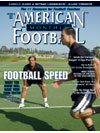AMERICAN FOOTBALL MONTHLY THE #1 RESOURCE FOR FOOTBALL COACHES
Article CategoriesAFM Magazine
|
OFF SEASON PLAYER DEVELOPMENT AND EVALUATION: THE KEY TO SUCCESSTHE MADERA WEIGHTROOMby: Randy Blankenship Madera High School, Consultant, Clinician, and Football Camp Director © More from this issue The off-season is key for our program and is my favorite time of the year. It is when we try to develop our team mentally, physically and build our relationships with each other. In the public school arena, we are dealt a group of players. We must develop them if we want to be able to compete in the fall. Player development and consistent evaluation is essential for a program. We believe you can change a player's ability through the weight room and competitive games throughout the spring. You can take a "C" player and improve him to a "B" player or a "B" player can improve to an "A-" player. We all would love to have a bunch of "A" players but in reality we get what we get. Those who develop their players in the off-season experience much more success. The evaluation process is to make sure we get each player in the posi....The full article can only be seen by subscribers. Subscribe today!
|
|
|||||||
| HOME |
MAGAZINE |
SUBSCRIBE | ONLINE COLUMNISTS | COACHING VIDEOS |
Copyright 2025, AmericanFootballMonthly.com
All Rights Reserved





